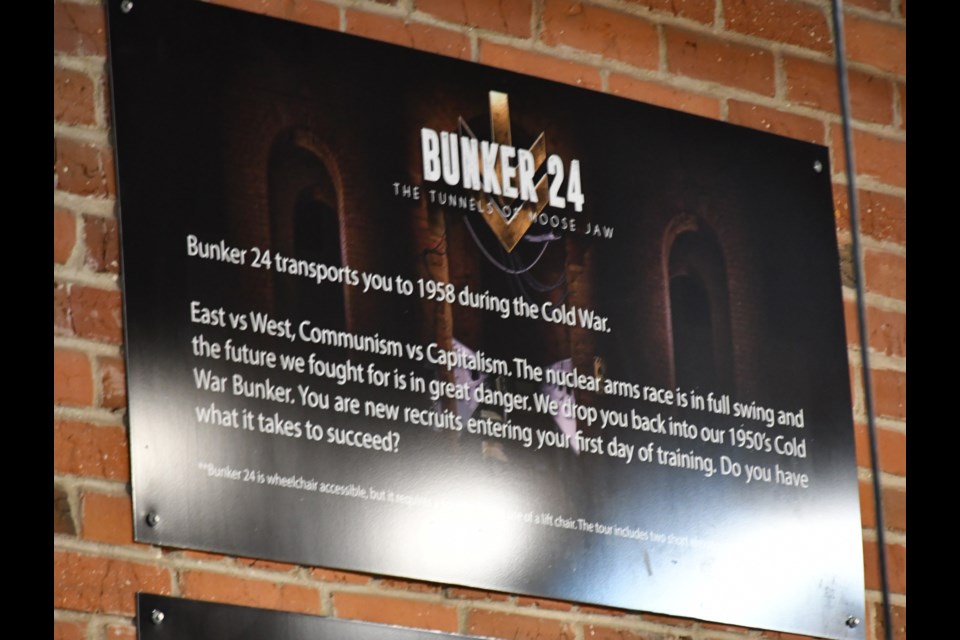MOOSE JAW — Beneath Moose Jaw’s streets lies a multi-room military bunker that offers a Canadian perspective on the Cold War, with the 1950s-era venue illuminated like a spy base — occasionally with a single light bulb or a computer screen.
“Bunker 24” is a tour that the Tunnels of Moose Jaw offers, and, as part of its 25th anniversary celebrations, the organization recently gave three special tours to small groups of people from the community and the province.
To communicate the tour’s stories authentically, the Tunnels brought in British veteran Kevin Hicks, who lives in Saskatoon and runs the YouTube channel “The History Squad.”
Hicks, 70, served with the Royal Military Police from 1976 to 1985 and was stationed in Germany, Ireland and Cyprus. During that time, he experienced several fascinating situations, which he communicated on the tour compellingly through his storytelling.
“I had an incredible career,” Hicks said on July 22, noting that he wanted to “put some flesh on the bones” about life during that time.
Being a military police (MP) officer did not mean just keeping the peace, he said.
Skulking in Germany
The veteran was sent to Berlin, Germany, where he thought he would police a former Nazi barracks, patrol the Berlin Wall and man checkpoints. Instead, he connected with an intelligence unit and patrolled through East Germany, which was “a totally different experience.”
Hicks recalled going on patrol with the intel unit and having to urinate. So, he found some bushes and was about to do his business when a battle tank roared past and nearly crushed him. He submitted a report to his superiors, who then “interrogated” him for seven hours over what he said.
Afterward, the Brit learned that he was the first Westerner to see the Soviet’s newest tank, the T-72. He also learned that the British Special Air Service (SAS) had undercover agents in the area who later found the machine.
On another occasion, Hicks saw Soviet T-62 tanks that were painted in colours different from usual, so he submitted another report. He later learned that the Soviets were rearming the East German army, which would be the “spearpoint” of the Warsaw Pact’s military alliance if it attacked the West.
Undercover work in Ireland
Hicks next went to Northern Ireland for two years, with the first year spent helping the Royal Ulster Constabulary. In his second year there, after he’d “learnt all of the ropes,” he was attached to a specialist unit dealing with anti-terrorism.
“I’ve never seen so much hatred in my life,” he said.
Hicks recalled attending a dinner event as part of undercover work and wearing a formal dinner jacket, which included a gun and enough ammunition “to sink a ship.” During that event, he blended in by drinking and dancing with a young woman, who unexpectedly found the gun.
He told her who he was, which upset her.
“She thought we were going to further and have some fun — but, unfortunately, no,” Hicks chuckled.
On another occasion, Hicks and his unit pretended to be a TV crew so they could film a large crowd, which included several well-known Irish terrorists. He noted that the conflict between the Catholics and Protestants was really a proxy war between the United States and the Soviet Union.
“That’s the thing with history. When you talk to people about the Cold War, they have no idea that it was quite hot and desperate,” Hicks said. “And it may have just simmered a little bit, but I believe it’s on the (rise again).”
Hicks was later posted to the Mediterranean island of Cyprus, to a small “protectorate village” called Pergamos, where he had “the most incredible time.” This area has Turkish roots, so he ate goats and birds and drank German beer because of Turkey’s connection to Germany in the First World War.
A new line of work
The veteran returned to the U.K. and served with 5 Airborne Brigade, which was supporting the deployment of nuclear missiles. However, he quit the military after his best friend, Dennis, was killed, and became a regular police officer.
He served for seven years in that role before he quit after a vehicle ran over him and left him for dead. He spent five years recovering before switching his focus to educating students about history.
Hicks and his wife moved to Saskatoon 12 years ago because his son married a Saskatchewan girl after serving in Afghanistan with the British military. Hicks later filmed several videos about the Tunnels for his YouTube channel. This caught the attention of the organization’s manager, who invited him to speak during the anniversary tours.
Continuing, he said Bunker 24 is an “absolutely brilliant” concept that gives people the illusion that they’re underground. He added that there are many real bunkers worldwide that are now in mothballs but were necessary decades ago if “the balloon had gone up.”
Visit tunnelsofmoosejaw.com for information about Bunker 24 and other tours.




